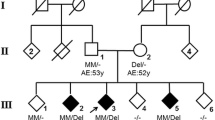Abstract
The term Levine-Critchley syndrome has been applied to an inherited multi-system degenerative neurological disorder associated with acanthocytosis in the absence of any lipid abnormality. Involuntary movements particularly affect the orofacial region and may cause dysarthria, dysphagia and vocalisations as well as tongue and lip biting which, when present, are virtually diagnostic. Psychiatric features, seizures, peripheral neuropathy and elevated plasma creatine kinase levels are all common. However, recent advances in molecular biology have shown the syndrome to be genetically heterogeneous, with mutations in at least two separate genes, both the CHAC and McLeod genes being associated with very similar phenotypes.
Access this chapter
Tax calculation will be finalised at checkout
Purchases are for personal use only
Preview
Unable to display preview. Download preview PDF.
Similar content being viewed by others
References
Brin MF (1993) Acanthocytosis. In: Vinken PJ, Bruyn GW, Klawans HL (eds) Handbook of Clinical Neurology. Elsevier, Amsterdam, pp 271–299
Brooks DJ, Ibanez V, Playford ED et al (1991) Presynaptic and postsynaptic striatal dopaminergic function in neuroacanthocytosis: A positron emission tomographic study. Ann Neurol 30: 166–171.
Critchley EMR, Clark DB, Wikler A (1967) An adult form of acanthocytosis. Trans Amer Neurol Assoc 92: 132–137.
Critchley EMR, Clark DB, Wikler A (1968) Acanthocytosis and neurological disorder without abetalipoproteinemia. Arch Neurol 18: 134–140.
Critchley EMR, Betts JJ, Nicholson JT, Weatherall DJ (1970) Acanthocytosis, normolipoproteinaemia and multiple tics. Postgrad Med J 46: 698–701.
Dervin JE, Kendall BK, Hardie RJ (1991) Neuroacanthocytosis: Correlation of clinical and neuroimaging abnormalities. Neuroradiology 33(Suppl): 575–577.
Dobson-Stone C, Danek A, Rampoldi L, Hardie R, Chalmers R, Wood N et al (2002) Mutational spectrum of the CHAC gene in patients with chorea-acanthocytosis. Eur J Hum Genet 10: 773–781.
Estes JW, Morley TJ, Levine IM, Emerson CP (1967) A new hereditary acanthocytosis syndrome. Amer J Med 42: 868–881.
Faillace RT, Kingston WJ, Nanda NC, Griggs RC (1982) Cardiomyopathy associated with the syndrome of amyotrophic chorea and acanthocytosis. Ann Intern Med 96: 616–7.
Gross KB, Skrivanek JA, Carlson KC, Kaufman DM (1985) Familial amyotrophic chorea with acanthocytosis. New clinical and laboratory investigations. Arch Neurol 42: 753–756.
Hardie RJ, Pullon HWH, Harding AE et al (1991) Neuroacanthocytosis. A clinical, haematological and pathological study of 19 cases. Brain 114: 13–49.
Ho MF, Chalmers RM, Davis MB, Harding AE, Monaco AP (1996) A novel point mutation in the McLeod syndrome gene in neuroacanthocytosis. Ann Neurol 139: 672–675.
Kartsounis LD, Hardie RJ (1996) The pattern of cognitive impairments in neuroacanthocytosis. Arch Neurol 53: 77–80.
Kito S, Itoga E, Hiroshige Y, Matsumoto N, Miwas S (1980) A pedigree of amyotrophic chorea with acanthocytosis. Arch Neurol 37: 514–517.
Levine IM, Estes JW, Looney JM (1968) Hereditary neurological disease with acanthocytosis: A new syndrome. Arch Neurol 19: 403–409.
Malandrini A, Fabrizi GM, Palmeri S et al (1993) Choreo-acanthocytosis like phenotype without acanthocytes: Clinicopathological case report. A contribution to the knowledge of the functional pathology of the caudate nucleus. Acta Neuropathol 86: 651–658.
Marsh WL (1983). Deleted antigens of the Rhesus and Kell blood groups: association with cell membrane defects. In: Garratty G (ed) Blood Group Antigens and Disease. American Assoc Blood Banks. Arlington, pp 165–185.
O’Brien CF, Schwarz J, Kurlan R (1990) Neuroacanthocytosis without acanthocytes. Mov Dis 5: 98.
Orrell RW, Amrolia PJ, Heald A et al (1995) Acanthocytosis, retinitis pigmentosa, and pallidal degeneration: a report of three patients, including the second reported case with hypoprebetalipoproteinaemia (HARP syndrome). Neurology 45: 487–492.
Peppard RF, Lu CS, Chu N, Martin WRW, Calne DB (1990) Parkinsonism with neuroacanthocytosis. Can J Neurol Sci 17: 298–301.
Rubio JP, Danek A, Stone C et al (1997) Chorea-acanthocytosis: genetic linkage to chromosome 9q21. Am J Hum Genet 61: 899–908.
Sorrentino G, De Renzo A, Miniello S, Nori O, Bonavita V (1999) Late appearance of acanthocytes during the course of chorea-acanthocytosis. J Neurol Sci 163: 175–178.
Tanaka M, Hirai S, Kondo S et al (1998) Cerebral hypoperfusion and hypometabolism with altered striatal signal intensity in chorea-acanthocytosis: a combined PET and MRI study. Mov Dis 13: 100–107.
Wimer BM, Marsh WL, Taswell HF, Galey WR (1977) Haematological changes associated with the McLeod phenotype of the Kell blood group system. Br J Haematol 36: 219–224.
Author information
Authors and Affiliations
Editor information
Editors and Affiliations
Rights and permissions
Copyright information
© 2004 Springer
About this chapter
Cite this chapter
Hardie, R.J. (2004). Levine-Critchley Syndrome of Neuroacanthocytosis: A Clinical Review. In: Danek, A. (eds) Neuroacanthocytosis Syndromes. Springer, Dordrecht. https://doi.org/10.1007/1-4020-2898-9_4
Download citation
DOI: https://doi.org/10.1007/1-4020-2898-9_4
Publisher Name: Springer, Dordrecht
Print ISBN: 978-1-4020-2897-7
Online ISBN: 978-1-4020-2898-4
eBook Packages: Biomedical and Life SciencesBiomedical and Life Sciences (R0)




